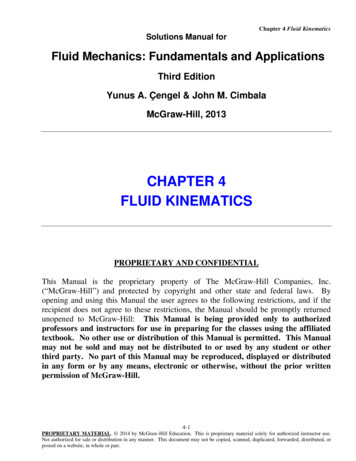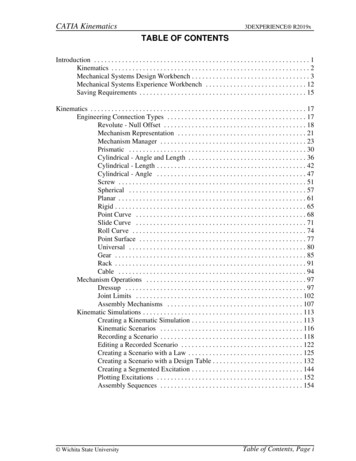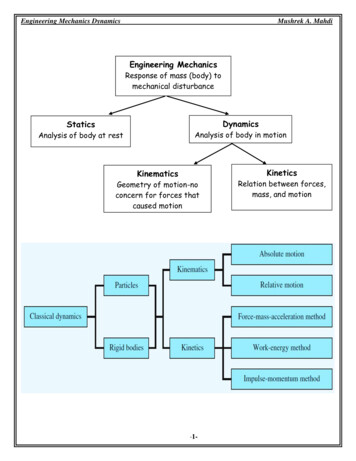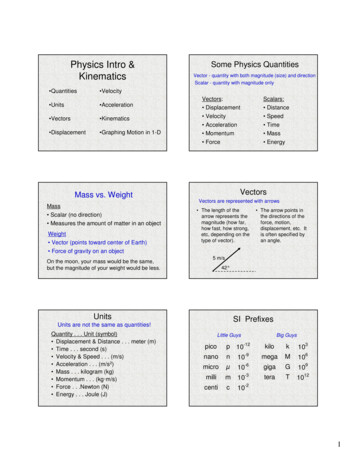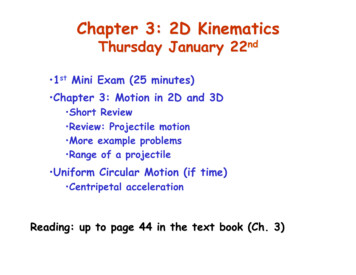
Transcription
Chapter 3: 2D KinematicsThursday January 22nd 1st Mini Exam (25 minutes) Chapter 3: Motion in 2D and 3D Short Review Review: Projectile motion More example problems Range of a projectile Uniform Circular Motion (if time) Centripetal accelerationReading: up to page 44 in the text book (Ch. 3)
Review: Components of vectorsResolving vector componentsax a cos θa y a sin θThe inverse processa ax2 a y2tan θ ayax
Review: Relative MotionTwo observers O and O’yOy’ball!'vb!vb!vO'O’x’x! !' !Velocity of ball observed in O: vb vb vO'
Projectile motion This series of photographicimages illustrates the fact thatvertical motion is unaffected byhorizontal motion, i.e., the twoballs accelerate downwards atthe same constant rate,irrespective of their horizontalcomponent of motion. In all of the projectile motionproblems that we will consider,we shall assume that the onlyacceleration is due to gravity(a -g) which acts in the –ydirection.
Equations of motion for constant accelerationEquationnumber3.83.9Equation! ! !v v0 at! ! !1 ! 2r r0 v0t 2 at! ! !22v v0 2 a ( r r0 )! !!1 !( r r0 ) 2 ( v0 v )t! !! 1!2( r r0 ) vt 2 atMissingquantity! !( r r0 )!vImportant: equations apply ONLY if acceleration is constant.t!a!v0
Equations of motion for constant accelerationThese equations work the same in any direction,e.g., along x, y or ionx x0vx v0 x ax tx x0 v0 x t ax t122v v 2ax (x x0 )2x20xvxtx x0 (v0 x vx )taxx x0 vx t ax tv012122Important: equations apply ONLY if acceleration is constant.
Equations of motion for constant accelerationThese equations work the same in any direction,e.g., along x, y or iony y0v y v0 y a y ty y0 v0 yt ayt122v v 2ay ( y y0 )2yvy20yty y0 12 (v0 y v y )tayy y0 vyt a ytv0 y122Important: equations apply ONLY if acceleration is constant.
Equations of motion for constant accelerationSpecial case of free-fall under gravity, ay -g.g 9.81 m/s2 here at the surface of the earth.EquationnumberMissingquantityEquationy y0v y v0 y gty y0 v0 y t gt122v v 2g( y y0 )2yvy20yty y0 12 (v0 y v y )tayy y0 v y t gtv0 y122
Demonstration
Projectile motion Motion in a vertical planewhere the only influence isthe constant acceleration dueto gravity. In projectile motion, thehorizontal motion and verticalmotion are independent ofeach other, i.e. they do notaffect each other. This feature allows us to break the motion into twoseparate one-dimensional problems: one for thehorizontal motion; the other for the vertical motion. We will assume that air resistance has no effect.
Analyzing the motionv0 x v0 cosθ 0v0 y v0 sinθ 0Initial coordinates x0 and y0Initial velocity v0 x iˆ v0 y ĵ
Horizontal motionvx v0 x axtax 0 vx v0 cosθ 0x x0 v0 x t ax t122x x0 ( v0 cosθ 0 ) t
Vertical motionv y v0 y a y ta y g v y v0 sin θ 0 gty y0 v0 y t a y t122y y0 ( v0 sin θ 0 ) t gt122
Maximum Range
The effects of airThe physicsprofessor's home runalways goes furtherthan theprofessional's
Uniform circular motion Although the speed, v, does notchange, the direction of themotion does, i.e., the velocity,which is a vector, does change. Thus, there is an accelerationassociated with the motion. We call this a centripetalacceleration.Δr rθΔv vθSame anglesΔv Δr vΔt vrr
Uniform circular motion Although the speed, v, does notchange, the direction of themotion does, i.e., the velocity,which is a vector, does change. Thus, there is an accelerationassociated with the motion. We call this a centripetalacceleration.Centripetal acceleration:2vac r(uniform circular motion) A vector that is always directed towards the center of thecircular motion, i.e., it’s direction changes constantly.
Uniform circular motion Although the speed, v, does notchange, the direction of themotion does, i.e., the velocity,which is a vector, does change. Thus, there is an accelerationassociated with the motion. We call this a centripetalacceleration.Centripetal acceleration:2vac r2π rPeriod: T (sec)v(uniform circular motion)11 vFrequency: f (sec 1 )T 2π r
c v2 r (uniform circular motion) . A vector that is always directed towards the center of the circular motion, i.e., it's direction changes constantly. Uniform circular motion Although the speed, v, does not change, the direction of the motion does, i.e., the velocity, which is a vector, does change.
